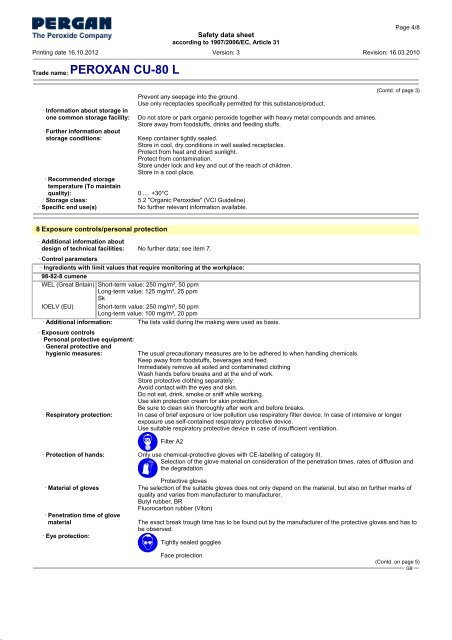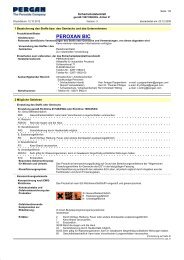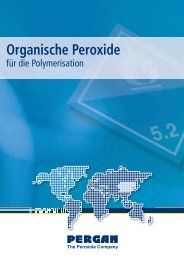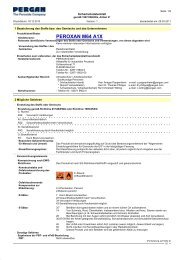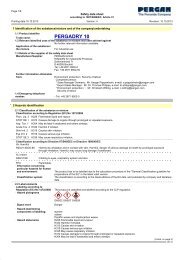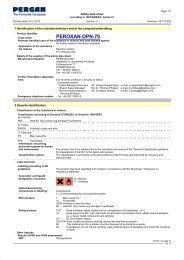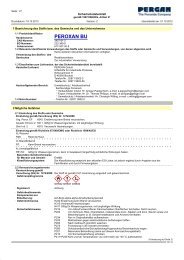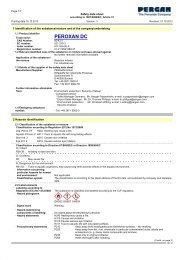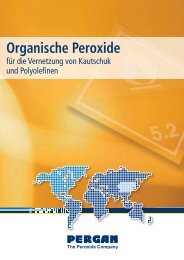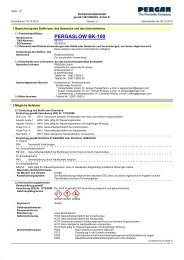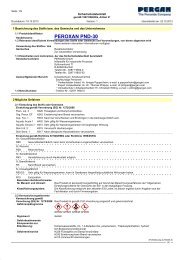PEROXAN CU-80 L - Pergan GmbH
PEROXAN CU-80 L - Pergan GmbH
PEROXAN CU-80 L - Pergan GmbH
You also want an ePaper? Increase the reach of your titles
YUMPU automatically turns print PDFs into web optimized ePapers that Google loves.
35.0.33<br />
Page 4/8<br />
Printing date 16.10.2012<br />
Safety data sheet<br />
according to 1907/2006/EC, Article 31<br />
Version: 3<br />
Revision: 16.03.2010<br />
Trade name: <strong>PEROXAN</strong> <strong>CU</strong>-<strong>80</strong> L<br />
(Contd. of page 3)<br />
Prevent any seepage into the ground.<br />
Use only receptacles specifically permitted for this substance/product.<br />
· Information about storage in<br />
one common storage facility: Do not store or park organic peroxide together with heavy metal compounds and amines.<br />
Store away from foodstuffs, drinks and feeding stuffs.<br />
· Further information about<br />
storage conditions: Keep container tightly sealed.<br />
Store in cool, dry conditions in well sealed receptacles.<br />
Protect from heat and direct sunlight.<br />
Protect from contamination.<br />
Store under lock and key and out of the reach of children.<br />
Store in a cool place.<br />
· Recommended storage<br />
temperature (To maintain<br />
quality): 0 .... +30°C<br />
· Storage class: 5.2 "Organic Peroxides" (VCI Guideline)<br />
· Specific end use(s) No further relevant information available.<br />
8 Exposure controls/personal protection<br />
· Additional information about<br />
design of technical facilities: No further data; see item 7.<br />
· Control parameters<br />
· Ingredients with limit values that require monitoring at the workplace:<br />
98-82-8 cumene<br />
WEL (Great Britain) Short-term value: 250 mg/m³, 50 ppm<br />
Long-term value: 125 mg/m³, 25 ppm<br />
Sk<br />
IOELV (EU) Short-term value: 250 mg/m³, 50 ppm<br />
Long-term value: 100 mg/m³, 20 ppm<br />
· Additional information: The lists valid during the making were used as basis.<br />
· Exposure controls<br />
· Personal protective equipment:<br />
· General protective and<br />
hygienic measures: The usual precautionary measures are to be adhered to when handling chemicals.<br />
Keep away from foodstuffs, beverages and feed.<br />
Immediately remove all soiled and contaminated clothing<br />
Wash hands before breaks and at the end of work.<br />
Store protective clothing separately.<br />
Avoid contact with the eyes and skin.<br />
Do not eat, drink, smoke or sniff while working.<br />
Use skin protection cream for skin protection.<br />
Be sure to clean skin thoroughly after work and before breaks.<br />
· Respiratory protection: In case of brief exposure or low pollution use respiratory filter device. In case of intensive or longer<br />
exposure use self-contained respiratory protective device.<br />
Use suitable respiratory protective device in case of insufficient ventilation.<br />
`Q<br />
Filter A2<br />
· Protection of hands: Only use chemical-protective gloves with CE-labelling of category III.<br />
Selection of the glove material on consideration of the penetration times, rates of diffusion and<br />
the degradation<br />
`S<br />
Protective gloves<br />
· Material of gloves The selection of the suitable gloves does not only depend on the material, but also on further marks of<br />
quality and varies from manufacturer to manufacturer.<br />
Butyl rubber, BR<br />
Fluorocarbon rubber (Viton)<br />
· Penetration time of glove<br />
material The exact break trough time has to be found out by the manufacturer of the protective gloves and has to<br />
be observed.<br />
· Eye protection:<br />
Tightly sealed goggles<br />
`R<br />
Face protection<br />
(Contd. on page 5)<br />
GB


